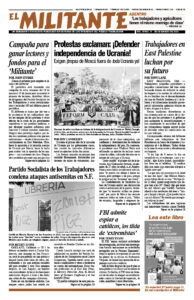ATHENS, Greece — Outraged at bosses’ disregard for the lives of workers and passengers, thousands of trade unionists and others rallied outside parliament here March 5. Called by rail unions, student and other organizations, the action protested the government’s responsibility for the death of 58 people in a collision between passenger and freight trains near Larissa in northern Greece Feb. 28.
At one action in the agricultural region of Thessaly near where the derailment took place, a March 8 protest by rail and other unions was joined by a farmers’ tractorcade.
Passengers included a number of students returning to Thessaloniki from Athens after a three-day holiday weekend. Eleven rail workers, including two drivers of the freight train and two drivers of the passenger train, were among the dead. Carriages were thrown off the rails and engulfed in flames with temperatures reaching 2,370 F after a head-on collision.
The two trains had been routed on the same track and were traveling toward each other for at least 12 minutes said Yiannis Ditsas, head of the rail unions. They collided because automatic switches that divert one train onto another line to prevent a crash were not working.
Rail workers and their unions have warned for some time of the increasing dangers as a result of job cuts and the deterioration of safety measures. They have been on strike since the crash.
The lack of investment in crucial safety provisions has been a consequence of government policy over many years.
Under pressure from the International Monetary Fund and European Union, the Greek rulers used the railways as an “asset” to acquire loans needed to prevent a government collapse. It sold off rail operator Trainose in 2017 to a private, for-profit Italian company. The government retained control of the tracks. The EU had threatened it would demand the return of a 700 million euros “aid” package ($747 million) if the sale didn’t go through. The EU is used by its dominant powers, the capitalist rulers in Germany and France, to plunder their weaker competitors in southern Europe with devastating consequences for workers.
Authorities quickly blamed the Larissa stationmaster for the collision, arresting him and charging him with negligent manslaughter. But the real reason for the disaster is “the drive for profit, not some individual stationmaster,” Panagiotis Katsaros, an air transport worker told the Militant. Katsaros is president of the Union of Workers at DHL at Athens Airport. The stationmaster “was on shift alone, without adequate training or experience and without the necessary alarm and control equipment,” he said.
“This puts front and center the need to build and strengthen unions.”
The March 5 protest was the third action in as many days. They were joined by thousands of students. Cops used tear gas to break up the overwhelmingly peaceful march.
Three rail unions issued a joint statement March 5. The Union of Workers and Employees at Trainose, the Pan-Hellenic Union of Trainose Employees and the Pan-Hellenic Union of Operating Personnel demanded the hiring of workers on permanent contracts, proper training and the building and maintaining of rail infrastructure. These steps, the unions say, would help safeguard workers, passengers and people living near rail lines. The railroad is supposed to have 2,000 workers but is currently operating with only 750.
Following the disaster the government has announced an inquiry.

